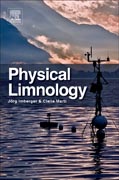
Physical Limnology provides the physical, chemical, and biological information practitioners need to effectively manage inland waters. Physical processes in lakes are known to have significant influence on driving the biology, chemistry, and geology in aquatic environments. In addition to covering the current knowledge in the area of lake physics, this helpful guide also provides coverage of some of the latest challenges in physical limnology. Physical Limnology also covers the mathematical modeling necessary to make basic calculations related to what is happening in lakes. Authored by one of the recognized world leaders in the fieldCovers the latest physical, chemical, and biological process information, making the work accessible to the general limnologist , lake practitioner, or biologistProvides examples from the author's experience working with lakes around the worldFeatures coverage of the latest challenges in physical limnology INDICE: 1. INTRODUCTION 1.1 Lakes, Reservoirs and Wetlands 1.2 Density of Water 1.3 Buoyancy and the Buoyancy Frequency 1.4 Influence of the Earth's Rotation 1.5 Seasonal variation of the thermal structure of standing waters 1.6 Definitions in Physical Limnology 2. TIME SCALES, DIMENSIONAL NUMBERS AND DYNAMICAL REGIME 2.2 Concept of Scales and Comparison of Scales 2.3 Characterizing External Forces on a Lake 2.3.1 Wind Set Up: Homogeneous Water Body: Ri 2.3.2 Wind Set Up; Stratified Water Body: W; LN 2.3.3 The Earth's Rotation: S 2.4 Littoral Exchange: Res 2.4.1 Differential cooling 2.4.2 Differential heating 2.4.3 Differential Wind Mixing 2.4.4 Topographic Gyres 2.5 Inflows: Fri 2.6 Outflows: Fro 2.7 Time scale hierarchies 3. SURFACE LAYER DYNAMICS 3.1 The Diurnal Surface Layer 3.2 Surface fluxes 3.3 Energetics of the Diurnal Surface Layer 3.4 The Structure of the Surface Layer 3.5 Horizontal dispersion 3.6 Upwelling 3.7 Differential deepening 3.8 Differential Heating and Cooling 3.9 Circulation in the Surface Layer 4. INTERNAL MOTIONS AND MIXING 4.1 The internal wave displacement spectrum 4.2 Origin and Fate of Internal Waves 4.3 Internal Wave Residual Circulations 4.4 Topographic effects 4.5 Temporal and Spatial Evolution of Mixing Patches 4.6 Natural convection and biological shading 5. BENTHIC BOUNDARY LAYER 5.1 The Structure of the Benthic Boundary Layer 5.2 Sources of Energy 5.3 Convective Fluxes 6. OUTFLOWS, INFLOWS AND INTRUSIONS 6.1 Selective Withdrawal 6.2 Gradually varied inflows 6.3 Inflows into Strong Stratification 6.4 Turbidity Currents 6.5 Intrusions 6.6 Through Flow Lakes 6.7 Flux path 7. COLD WATER LAKES 7.1 Formation of Ice Cover 7.2 Convective Motions under Ice Cover 7.3 Convective Motions Sustained by Bottom Heating 7.4 The Effect of the Density Maximum 8. CIRCULATION IN HOMOGENEOUS LAKE 8.1 Topographic Gyres 8.2 Tides in Lakes 9. ENGINEERING INTERVENTIONS 9.1 The Flux Path in a Stratified Lake 9.2 Bubbler destratification 9.3 Automatic control of vertical stratification 9.4 Oxygenation 10. FIELD INVESTIGATIONS 10.1 Introduction 10.2 In situ data streams 10.3 Fine scale profilers 10.4 Microstructure flux measurements 10.5 Remote sensing 10.6 Real-time process field work 11. MODELLING 11.1 The Dynamic Reservoir Simulation Model: DYRESM 11.2 Estuary, Lake Computational Model: ELCOM 11.3 CAEDYM 11.4 ARMS 11.5 RMSO 12. FUTURE CHALLENGES 12.1 Tyranny of the physical timescale hierarchy 12.2 Deep Lakes 12.3 Long term global warming simulations 12.4 Energy cascade 12.5 Biological feedback: Macrophytes: Natural Convection 12.6 Horizontal dispersion 12.7 Complexity of bathymetry
- ISBN: 978-0-12-404565-1
- Editorial: Elsevier
- Encuadernacion: Rústica
- Páginas: 320
- Fecha Publicación: 02/06/2017
- Nº Volúmenes: 1
- Idioma: Inglés
